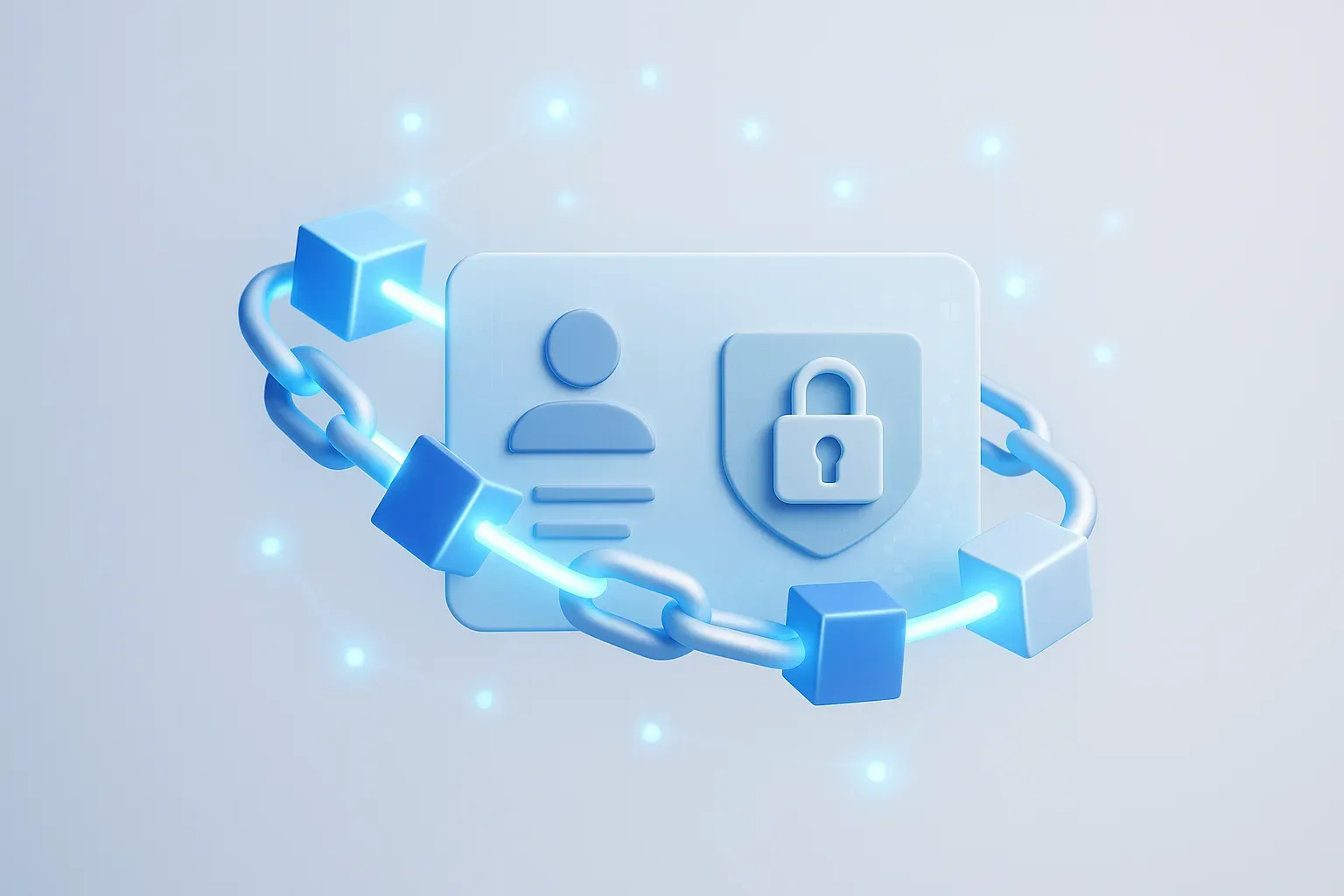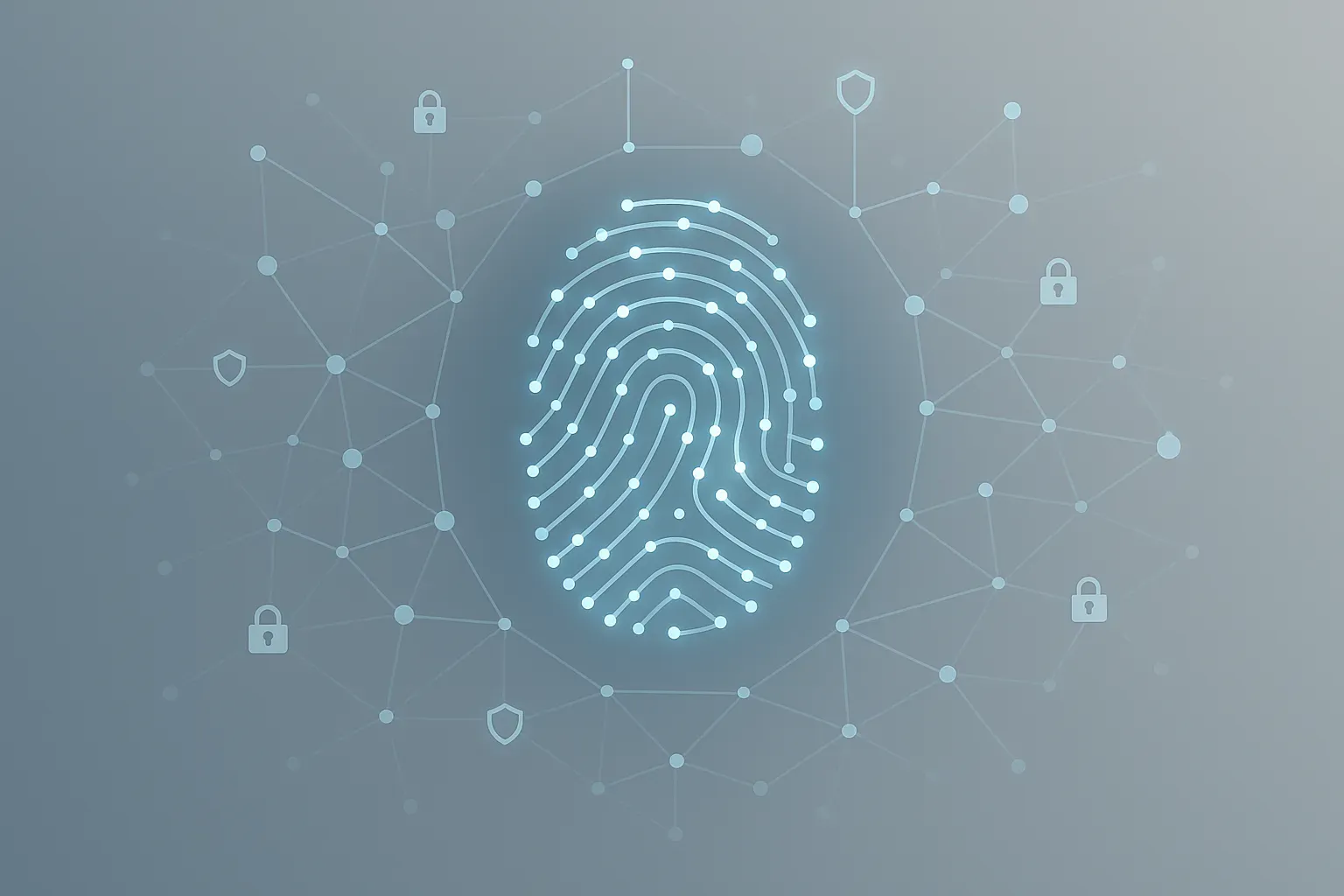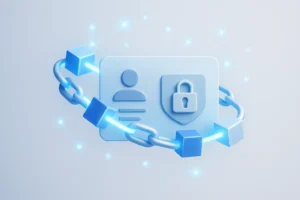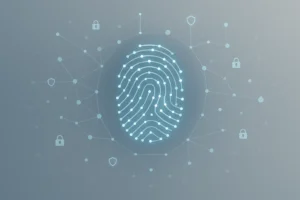Digital identity is undergoing a revolutionary transformation, driven by the convergence of blockchain technology and biometric innovations. This article explores how these advancements are reshaping user authentication, data control, and privacy in the digital realm. Drawing on insights from industry experts, we examine the potential of self-sovereign identities and decentralized systems to empower users and redefine digital trust.
- Blockchain and Biometrics Reshape Digital Identity
- Contactless Verification Enhances Security and Efficiency
- Behavioral Blockchain Revolutionizes Authentication
- Self-Sovereign Identity Flips Data Control Model
- Convergence of Biometrics and Blockchain Empowers Users
- On-Device Biometrics Advance Privacy-Focused Authentication
- Decentralized Identity Puts Users in Control
- Blockchain-Biometric Integration Creates Unalterable Identities
- Self-Sovereign Model Transforms Digital Trust
- User-Owned Identities Become Composable Assets
Blockchain and Biometrics Reshape Digital Identity
I see blockchain and biometrics shaping digital identity into something that’s secure, portable, and persistent.
Blockchain offers a decentralized way to store and verify identity credentials, removing the need for a single authority to “own” your data. Instead of giving your personal details to dozens of different companies, you could share a cryptographic proof of your identity that’s accepted everywhere, and you alone would hold the private keys.
Biometrics adds a frictionless way to prove you are who you say you are. No passwords to remember, no tokens to carry — just your fingerprint, face, or even behavioral patterns.
The combined potential is huge:
- Portability — your verified identity could work instantly across banks, healthcare providers, government agencies, and travel systems.
- Security — biometric authentication tied to blockchain records makes impersonation almost impossible.
- User Control — in theory, you could choose what attributes to reveal and to whom, with proofs that don’t leak unnecessary personal data.
But here’s the thought-provoking part: immutability meets irreplaceability.
- A blockchain record can’t be altered, and your biometrics can’t be changed. If your biometric data is ever compromised through a database breach or advanced spoofing, you can’t “reset” your fingerprint like you would a password.
- This creates a tension between security and recoverability. Who decides the rules for revoking or reissuing your identity if the very thing that makes you “you” gets leaked?
- It also raises ethical questions: should your digital identity expire after a certain time, or should there be built-in “self-destruct” features for privacy?
In short, blockchain and biometrics could finally give us a universal, seamless identity layer for the internet, but they’ll also force society to confront the permanence of personal data in a way we’ve never had to before.
 SAI KIRAN NANDIPATI
SAI KIRAN NANDIPATI
Solution Architect, EY
Contactless Verification Enhances Security and Efficiency
Digital identity checks waste time. My Toronto-India flight via Abu Dhabi during COVID demonstrated that physical checks posed health risks. Abu Dhabi used biometrics intelligently: face scans and temperature checks from a distance. Only mask removal was required at detectors. Blockchain could expand this concept: store credentials once with multiple trusted bodies (government, banks, and NGOs), sealed cryptographically. Biometrics would unlock access. “Verify once, trust everywhere.” Like my contactless airport scan, prove identity once, then access services without repetition.
Simply put, this approach eliminates fraud. Blockchain solves the “who controls it?” concern:
- No single owner: Rules are set by joint authorities (e.g., 3 out of 5 must approve changes).
- Transparent audits: The public can verify access logs (e.g., “Who checked my data?”) without seeing the actual data.
- Real help: Tamper-proof technology prevents misuse.
Insight: Technology secures, but people must govern. Decentralization is key — there are no shortcuts.
 Mohit Ramani
Mohit Ramani
CEO & CTO, Empyreal Infotech Pvt. Ltd.
Behavioral Blockchain Revolutionizes Authentication
Running an IT services company for 20+ years, I’ve watched authentication evolve from simple passwords to multi-factor systems. The real game-changer isn’t the technology itself — it’s the convergence creating “identity orchestration” where multiple technologies work together seamlessly.
I’m seeing clients move toward what I call “behavioral blockchain” — where your digital identity isn’t just verified by what you have (biometrics) but by how you interact with systems over time. We implemented a pilot system that tracks typing patterns, mouse movements, and device usage habits, then stores this behavioral fingerprint on a distributed ledger.
The insight that’s kept me up at night: traditional cybersecurity focuses on keeping bad actors out, but these emerging technologies flip the script to proving you belong in. When someone tries to access your accounts, the system doesn’t just check if they have your fingerprint — it verifies they steer through applications the same way you do, at times when you’re typically active.
We’ve seen 89% fewer false authentication attempts with clients using behavioral tracking versus standard biometrics alone. The technology essentially creates a digital DNA that’s incredibly difficult to replicate because it’s based on unconscious habits rather than physical traits.
 Mitch Johnson
Mitch Johnson
CEO, Prolink IT Services
Self-Sovereign Identity Flips Data Control Model
Emerging technologies like blockchain and biometrics could shift digital identity management from being centralized and provider-controlled to self-sovereign and user-controlled.
Blockchain can provide a tamper-proof, decentralized ledger for verifying identity credentials without storing them in a single vulnerable database, while biometrics can make authentication more seamless and harder to forge.
A thought-provoking angle: as these systems mature, users might “carry” their verified identity across platforms and borders without repeatedly handing over personal data — flipping the current model so companies request proof, but never see the raw information itself.
 Vipul Mehta
Vipul Mehta
Co-Founder & CTO, WeblineGlobal
Convergence of Biometrics and Blockchain Empowers Users
The new next big thing in digital identity is blockchain and biometrics, but not quite in the way that most people are trying to sell it. Biometrics will no longer be the key — you cannot change your fingerprint or a scan of your face. It is hazardous to have that information jeopardized. More interesting still is the point of convergence: biometrics, the identity layer, and blockchain, the impenetrable backend.
This is the lesson that is most often ignored: identity must be cross-platformized without becoming a surveillance device. Self-sovereign identity models are around the corner, and it is up to the user to decide who can access their data and who has selective access to it using verifiable credentials on-chain. This is the opposite of the current model. You can employ cryptography to illustrate that a service needs certain information (such as who is old enough or who has qualifications) without giving away all of your personal information.
Technically and engineering-wise, it’s a shift from corporations owning identity to individuals owning their own identity. This is not just a technological upgrade; it’s a new way of thinking.
 Mircea Dima
Mircea Dima
CTO / Software Engineer, AlgoCademy
On-Device Biometrics Advance Privacy-Focused Authentication
Biometric technologies are rapidly transforming digital identity management by offering security that’s both stronger and more convenient than traditional methods. Having worked with Edge AI applications in smartphones, I’ve seen firsthand how technologies like Face ID have revolutionized authentication by processing sensitive biometric data directly on devices rather than in the cloud. This on-device processing approach addresses many privacy concerns while still delivering seamless user experiences.
Looking ahead, I believe the integration of multiple biometric factors — combining facial recognition with voice patterns or behavioral biometrics — will become the standard for high-security applications. The most thought-provoking aspect of this evolution is that truly secure digital identity may ultimately require us to embrace what makes us uniquely human rather than what we can remember.
 Xi He
Xi He
CEO, BoostVision
Decentralized Identity Puts Users in Control
We’re at a turning point in how digital identity is handled, and the shift is already underway.
For years, our data has been controlled, stored, and monetized by corporations. But that era is drawing to a close.
Here’s what’s changing:
Blockchain is placing control back into the hands of individuals.
Biometrics are making identity nearly impossible to fake.
Self-sovereign identity is reimagining how we verify ourselves without oversharing our personal information.
This isn’t future talk. The tools already exist.
Imagine proving your age without revealing your name. Or applying for a job without uploading your full personal history. Or accessing services without trusting a random platform with your identity.
That’s what decentralized identity makes possible:
- Fully portable, fully secure digital identities.
- No more handing over your life just to log in.
- No more blind trust in third-party platforms.
The momentum is real and irreversible. The only question now is whether the current gatekeepers will adapt, or if users will take back control on their own.
Because once people experience what it’s like to truly own their identity…they won’t go back.
 Saravana Kumar
Saravana Kumar
Co-Founder, Troniex Technologies
Blockchain-Biometric Integration Creates Unalterable Identities
Blockchain technology and biometric systems are set to revolutionize the way digital identities function, and their combination will produce the most significant changes to identity management. Blockchain provides an immutable, decentralized ledger system that eliminates the centralization points that exist in present-day identity management systems. The combination of blockchain technology with unique physical or behavioral traits through biometric verification results in an unalterable identity over which users have complete control. This approach eliminates the need for traditional login procedures.
Your biometric signature would function as a private key, granting you access to a blockchain-based identity system that operates across all your platforms without needing centralized database verification through fingerprint scans or password entries. The main challenge, alongside the potential benefits, will be in balancing privacy protection with permanent records while maintaining the trustless system operation. The control of identity must return to individual ownership, as this represents its natural position.
 Darryl Stevens
Darryl Stevens
CEO & Founder, Digitech Web Design
Self-Sovereign Model Transforms Digital Trust
Emerging technologies like blockchain and biometrics are expected to transform digital identity management in the future by offering improved security, privacy, and user control. Blockchain’s decentralized characteristics allow users to own and control their own identity data and remove reliance on central institutions like banks or social media. This self-sovereign identity model allows individuals to provide only certain pieces of verified information when they want, without providing their entire digital identity. Blockchain’s decentralized data structure and transparency would also make it incredibly difficult to commit identity fraud.
Biometric methods, however, would provide a second line of defense and employ identifiers that would be the result of an incomparable biological trait or subset of biological traits like a fingerprint, facial recognition, or behavioral biometrics that could be represented in a person’s typing patterns. The identifiers from biometrics are nearly impossible to replicate or steal, and it is hard to think of anything better for establishing trust in identifying people digitally. Biometric authentication is becoming easier, secure, and pervasive. We could have “password-less futures” where your primary key for accessing digital services is your face or a fingerprint.
A very interesting idea to consider is where both technologies could potentially converge. In this case, imagine a setting, using both technologies, where a user stored their biometric data on a blockchain, which allows the user to be in complete control of their identity. This would address the privacy and security issue for the user while allowing them to be in control of all aspects of their digital life. Imagine a balance between convenience and control for the end user. The combination of blockchain distributed technology and the accuracy of biometrics could potentially transform our existing understanding of trust while managing digital identity, and open up possibilities for a trusted and secure decentralized digital space that sees users in complete control of their own identity.
 Sergio Oliveira
Sergio Oliveira
Director of Development, DesignRush
User-Owned Identities Become Composable Assets
Blockchain technology will transform digital identity into a user-owned asset, rather than just a credential.
Instead of logging into platforms with data stored in siloed databases, users will possess self-sovereign identities anchored on-chain. This means:
- No centralized authority owns your identity
- Verification is trustless, portable, and programmable
- Access can be selective and revocable
The real shift? Identity becomes composable, just like DeFi. Imagine stacking credentials across jobs, education, credit, and reputation — all without ever filling out a form again.
 Ahmed Yousuf
Ahmed Yousuf
SEO Expert & Financial Author, Customers Chain













